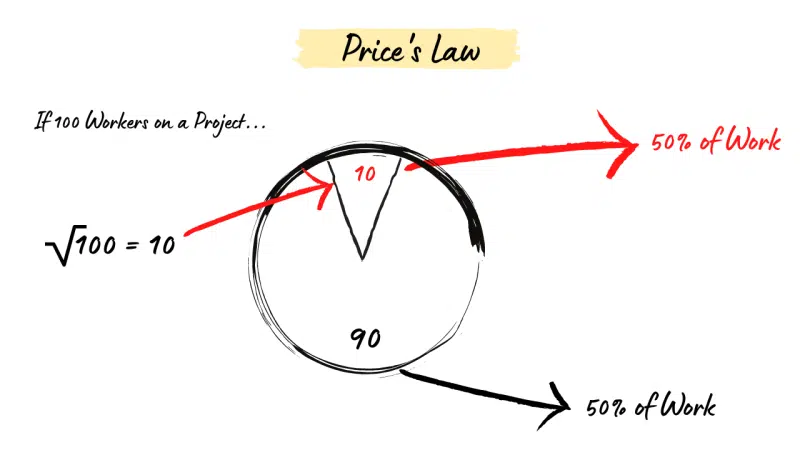Derek Price was a British physicist and scientist who made a unique observation about his academic peers He noticed that a small percentage of them were making most of the contributions to their field. From this he developed "Price's Law." (also known as Price's Square Root Law) which states that 50% of all work will be done by the square root of the total number of people who take part in the work.

In business, when a company grows, competence grows linearly and incompetence grows exponentially. The larger you become, the larger the number of people who aren't carrying their weight becomes.

Price's Law Example
Let's use some basic, quantifiable numbers to make sense of this.
Let's say you have 100 people working on a project and we measure output in sales made in whole number units. The total number of sales is 1,000.
Price's Law would suggest that with all things being equal, if left to their own devices, 10 (10%) of the employees would make 500 (50%) of the sales. The other 90 (90%) sales people on the project would make the remaining 500 sales.
If the number of people working on the project was a smaller number such as 9, we'd expect 3 of them to do 50% of the work (500 sales) and the other 6 to do the remaining 50% (500 sales).
Price's Law in the Real World
First, remember that Price's law is merely an idea/theory and not a scientific fact. It is like Pareto's Principle and is more of a rule of thumb than a perfect algorithm that works in all cases.
The underlying concept is that a small fraction of your team will do most of your work.
This is good news because it means that we can actually work to optimize our teams so that it isn't 10% doing half of the work! It's not as if there is a rule of nature that is binding us to this ratio.
No, in fact, we can work to keep and hire people who will be in this "10%." We can set a higher standard and work to shrink the 90% and increase the 10%.
We can do proactive things such as reducing the size of teams so that accountability is higher, and it's not as easy for team members to hide within the majority that is relying on the minority.


i just wanted to say thank you for posting this. This information answers a GREAT many questions I've had about government/politics, corporate culture and the military. As an engineering type it was gratifying to see people had tried to work this out quantitatively. Thanks again.
Actually it is a rule of nature… That's why it's called a law. Admittedly we don't understand why. If you hire new people the distribution will remain the same but it may change in regards to the individuals that represent it. This has a proven many times.